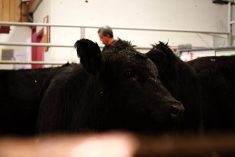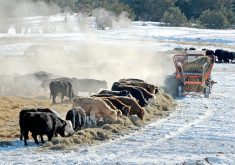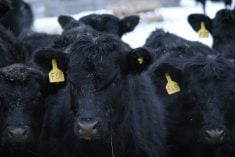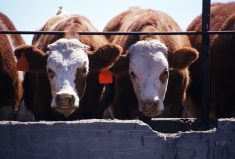Western Canadian feeder cattle prices were relatively unchanged from week-ago levels. Eastern Prairie markets were softer but continue to maintain a $5 to as much as $8 premium over major feeding regions of Alberta. We’ve seen a sharp year-over-year increase in imports from the U.S., which is causing a variable price structure to develop across the Prairies.
Buyers were more discerning this week on quality features. Larger discounts were noted on unweaned or semi-weaned calves. Concessions were also made on fleshier yearlings. Feeding margins remain under pressure, especially in the deferred positions; therefore, it’s not uncommon that buyers become more fussy. Alberta fed cattle prices were quoted from $148 to $150, unchanged from the previous week.
Read Also

U.S. grains: Corn and wheat futures firm on brisk exports, softer dollar
U.S. corn and wheat futures firmed on Thursday, supported by brisk export sales and a softer dollar, which tends to make U.S. grains more competitive globally, analysts said. Soybean futures clung to modest gains.
Simmental-cross medium-frame, medium- to heavier-flesh steers averaging 930 lbs. were quoted at $195 landed in southern Alberta; Simmental-cross larger-frame medium-flesh heifers averaging 890 lbs. were reported at $193 in the same region. Yearling prices have strengthened to the point that there is minimal or no margin for the first quarter of 2018. Therefore, buyers were shying away from yearlings, resulting in fortuitous price behaviour at times.
Prices for feeders in the 500- to 800-lb. categories were quite firm; major feedlots were noticeably more aggressive for 700-plus-lb. cattle, causing price spreads between weight categories to narrow. Unweaned 550-lb. mixed calves were quoted at $210 in central Alberta while Charolais-cross larger-frame medium-flesh steers weighing 775 lbs. traded for $206. Buyers were on their toes receiving orders with strict quality features and price limits.
Featherlight calves under 500 lbs. experienced strong buying interest, especially in southern Saskatchewan. Feeding these lighter calves over the winter appears to be better value compared to market levels on grass cattle next spring. There are some anomalies occurring in the futures, whereby the March feeder board is too high-priced relative to the August live cattle. This may be the underlying factor, along with the weaker Canadian dollar, driving the young calves to historical high price levels.
— Jerry Klassen manages the Canadian office of Swiss-based grain trader GAP SA Grains and Produits Ltd. and is president and founder of Resilient Capital, specializing in proprietary commodity futures trading and market analysis. Jerry consults with feedlots on risk management and writes a weekly cattle market commentary. He can be reached at 204-504-8339.
















